|
The Monistic Theory
by Nhân Tử Nguyễn Văn Thọ
TOC |
Preface | Chapters:
1 2
3 4
5 6
7 8
9
10 11
12 13
14 15
16 17
18 19
Chapter 10
Freemasonry and the Monistic Theory
Freemasonry is a Secret Society. No one
knows for sure when it makes its appearance in the West, but agrees that
the modern history of Freemasonry begins on June 24, 1717, when the
Grand Lodge of England, an association of lodges, was inaugurated. Grand
Lodges were subsequently founded in other countries accepting
Freemasonry. Anyhow, it evolves from the guilds of stonemasons and
cathedral builders of the Middle Ages. Freemasonry is spread by the
advance of the British Empire, and remains most popular in the British
Island and in other countries originally within the Empire. Of the world
estimated 5,900,000 Freemasons, 4,000,000 lives in the United States,
and 1,000,000 live in the British Isles. There are now in the United
States and Canada a total of 57 Grand Lodges.
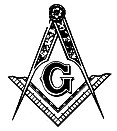
Freemasonry has almost from its inception,
encountered considerable opposition from organized religion, especially
from the Roman Catholic Church and from various states. It is banned in
the USSR, Hungary, Poland, Spain, Portugal, China, Indonesia, The United
Arab Republic etc
Some of the greatest and most prominent
men in the world have been Masons. Among these are Giuseppe Garibaldi,
Louis Kossuth, The Marquis de Lafayette, Benjamin Franklin, and George
Washington.
Freemasonry contains many of the elements
of a religion; its teachings enjoin morality, charity, and obedience to
the laws of the land. For admission, the applicant is required to be an
adult male, believing in the existence of a Supreme Being and in the
immortality of the soul. In most lodges in most countries, Freemasons
are divided into three major degrees - entered apprentice, fellow of the
craft, and master mason...
Freemasonry is the subjugation, said
Albert Pike, of the Human that is in man by the Divine; the Conquest of
the Appetites and Passions by the Moral Sense and the Reason; a
continual effort, struggle, and warfare of the Spiritual against the
Material and Sensual... Every Degree of the Ancient and Accepted
Scottish Rite, from the first to the thirty-second, teaches by its
ceremonial as well as by its instruction, that the noblest purpose of
life and the highest duty of a man are to strive incessantly and
vigorously to win the mastery of everything, of that which in him is
spiritual and divine, over that which is material and sensual; so that
in him also, as in the Universe which God governs, Harmony and Beauty
may be the result of a just equilibrium.
Masonry is a search after Light. That
search leads us directly back, as you see, to the Kabalah. In that
ancient and little understood medley of absurdity and philosophy, the
Initiate will find the source of many doctrines; and may in time come to
understand the Hermetic philosophers, the Alchemists, all the Anti-papal
thinkers of the Middle Ages, and Emmanuel Swedenborg.
It is for each individual Mason to
discover the secret of Masonry, by reflection upon its symbols and a
wise consideration and analysis of what is said and done in the work.
Masonry does not inculcate her truths. She states them, once and
briefly; or hints them, perhaps, darkly; or interposes a cloud between
them and eyes that would be dazzled by them. "Seek, and ye shall find,"
knowledge and the truth.
The practical object of Masonry is the
physical and moral amelioration and the intellectual and spiritual
improvement of individuals and society...
It is the universal, eternal, immutable
religion, such as God planted in the heart of universal humanity. No
creed has ever been long-lived that was not built on this foundation. It
is the base, and they are the superstructure. "Pure religion and
undefiled before God and the Father is this, to visit the fatherless and
widows in their affliction, and to keep himself unspotted from the
world." "is not this the fast that I have chosen? to loose the bands of
wickedness, to undo the heavy burdens, and to let the oppressed go free,
and that ye break every yoke?"...
The whole world is but one republic, of
which each nation is a family, and every individual a child. Masonry,
not in anywise derogating from the differing duties which the diversity
of states requires, tends to create a new people, which composed of men
of many nations and tongues, shall all be bound together by the bonds of
science, morality and virtue...
For the public, Freemasonry teaches an
universal brotherhood.
Looking at it closely, we find its
teachings rather complicated. There is a mixture of Rosicrucians, of
Kabalah, of Alchemy, and of Astrology. It conveys the truth to its
followers by means of symbols, but few can understand them. Their true
explication is reserved for the Adepts, the Princes of Masonry. As an
outsider to the Society, I try to understand it through the Monistic
Theory:
The Mackey's Revised Encyclopedia of
Freemasonry explains the Theory of Emanation or the Monistic Theory
as follows:
The Theory of Emanation has flourished in
many Eastern Religions, especially in Brahmanism and in Parseeism.
Afterward, Kabalah and Gnosticism have also accepted it. Philo and Plato
have taught it.
This theory sustains that everything
emanates from the Absolute. Therefore, in Brahmanism the Cosmic Soul,
from which everything emerges, is equated with Brahma or God.
Gnostics sustain that everything come from
a Spiritual Reality. Everything derives from it, from the high to the
low, and the final salvation is that in the final state, everything will
return to the purity of the Creator.
Philo teaches that the Absolute, or The
Original Light has brought forth its rays to illuminate all the souls,
in that case everything comes from the One. The Emanation Theory has
been also accepted by Freemasonry, and all its grades often mentioned
this theory common to The Kabalah, to Philo and to The Gnostics.
Albert Pike frequently mentions this
Theory in his book. He said, for instance: "The source of our knowledge
of the Kabbalistic doctrines, are the books of Jezirah and Sohar, the
former drawn up in the second century, and the latter a little later;
but containing materials much older than themselves. In their most
characteristic elements, they go back to the time of the exile. In them,
as in the teachings of Zoroaster, EVERYTHING THAT EXISTS EMANATED FROM A
SOURCE OF INFINITE LIGHT. Before everything, existed the ANCIENTS OF
DAYS, THE KING OF LIGHT; a title often given to the Creator in the
Zend-Avesta and the code of Sabaeans. With the idea so expressed is
connected the pantheism of India. The King of Light, The Ancient, is ALL
THAT IS. He is not only the real cause of all Existences; he is Infinite
(AINSOPH). He is HIMSELF; there is nothing in Him that we can call Thou.
In the Indian doctrine, not only is the
Supreme Being the real cause of all, but he is the only real existence;
all the rest is illusion. In the Kabalah, as in the Persian and Gnostic
doctrines, He is the Supreme Being unknown to all, the "Unknown Father."
The world is his revelation, and subsists only in Him. His attributes
are reproduced there, with different modifications, and in different
degrees, so that the Universe is His Holy Splendor: it is but His
Mantle; but it must be revered in silence. ALL BEINGS HAVE EMANATED FROM
THE SUPREME BEING; the nearer a being is to Him, the more perfect it is;
the more remote in the scale, the less its purity.
In another place, he writes about
Gnosticism as follows: "Emanation from the Deity of all spiritual
beings, progressive degeneration of these beings from emanation to
emanation, redemption and return of all to the purity of the Creator;
and after the re-establishment of the primitive harmony of all, a
fortunate and truly divine condition of all, in the bosom of God; such
were the fundamental teachings of Gnosticism...
Behold, it is said, the light, which
emanates from an immense center of Light, that spreads everywhere its
benevolent rays; so do the spirits of Light emanate from the Divine
Light. Behold, all the springs which nourish, embellish, fertilize and
purify the Earth; they emanate from one and the same ocean; so from the
bosom of the Divinity emanate so many streams, which form and fill all
the universe of intelligence. Behold numbers, which all emanate from one
primitive number, all resemble it, all are composed of its essence, and
still vary infinitely; and utterances, decomposable into so many
syllables and elements, all contained in the primitive Word, and still
infinitely various; so the world of Intelligence emanated from a
Primitive Intelligence, and they all resemble it, and yet display an
infinite variety of existences."
The One and the Multiple can be
represented by: The Center and The Circle, the Center being The One, the
Universal Cause; The Circle outside being the Multiple, the Effects.
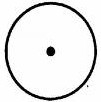
Or by the Ouroboros, biting its tail,
encircling the Greek word: EN TO PAN meaning that ALL IS ONE. The
Ouroboros biting its tail, represents the Eternity.
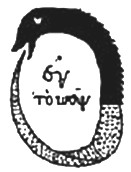
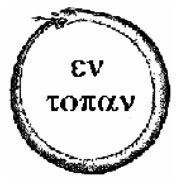
The Ouroboros
Serpent
The conception: FROM THE ONE, EVERYTHING
EMITS is represented by this symbol:
a) Two interlaced Triangles representing
two poles Yin and Yang, containing in themselves the Ineffable Name,
written in the Enoch Alphabet:
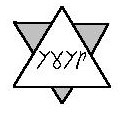
b) Or by a triangle having in its center
an Eye, or the Hebrew name of Jehovah, Yod, He, Vau, He.

From it, we see many rays coming out. This
convey the idea of Emanation. On the periphery, we see a circle of
Clouds, meaning all beings. The whole picture is the scheme of The Being
with all its multiple manifestations.
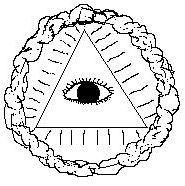
c) Or by “The hexagon formed by six
triangles, whose apices converge to a point...This is a symbol of the
universal creation, the six points crossing the central point; thus
assimilating the hexagon to the older symbol of the point within a
circle...
The process of Emanation: One into Two,
Two into Four is similar to that of the Yi Jing.
The Two or the Yin and the Yang is
represented or by Two Columns in Salomon’s temple: Booz and Jakin; The
Yin is The B (Booz), the Yang is the J (Jakin).
Or by 2 triangles diametrically opposed:
One turning upward representing the Fire or the Yang, One turning
downward representing the Water or the In.
These two triangles are frequently
represented interlaced, meaning that all the changes in this world is
due to their united forces.
The Four Elements: Earth, Water,
Fire, Air is represented in this way:
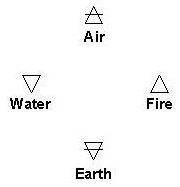
We see that Air is Fire with an horizontal
line, borrowed from Water, and Earth is Water with an horizontal line,
borrowed from Fire.
The idea that God resides in Man, and that
the Initiate should radiates God around him is represented by a
Pentagram, or a Blazing Star emitting rays around, and with a Majuscule
G in it. The Pentagram represents a man, and the G is an abbreviation
for God.
As for the deification of man, or his
union with God, Albert Pike, thus spoke: "When man's consciousness of
his own intellectuality was mature, and he became convinced that the
internal faculty of thought was something more subtle than even the most
subtle elements, he transferred that new conception to the object of his
worship, and deified a mental principle instead of a physical one. He in
every case makes God after his own image; for do what we will, the
highest efforts of human thought can conceive nothing higher than the
supremacy of intellect; and so he ever comes back to some familiar type
of exalted humanity. He at first deifies nature, and afterward himself.
The eternal aspiration of the religious
sentiment in man is to become united with God...
In this short study of Freemasonry, I try
to demonstrate that it upholds the Theory of Emanation, and because of
it, has many connections with all the Middle Age thinkers, such as, with
Rosicrucians, with Kabalists, with Alchemists, with Philo, with Plato,
with Pythagoras etc
Its tends to reach Harmony and Beauty
which will results in a just equilibrium. It sustains the "Restitutio at
integrum" of everything or Apocatastasis, which means that all things,
after a cycle of ages, would return to their original condition, to
their primitive purity.
Encyclopaedia Britannica,
1979, Tome IV, Article
Freemasonry, p. 302.
Britannica Junior,
Encyclopaedia Britannica, Inc. Chicago. London. Toronto, Vol. VI,
Article Freemasonry. pp. 201-202
Encyclopaedia Britannica, 1929,
Vol. 9, Article Freemasonry, pp. 732
-739.
Albert Pike, Morals and Dogma of the Freemasonry, p. 741.
The ancient symbol of Eternity
was a serpent in the form of a circle, the tail being placed in the
mouth. The simple circle, the figure which has neither beginning nor
end, but returns continually into itself, was also a symbol of eternity.
Mackey's Revised Encyclopedia of Freemasonry.
p. 340, vol. I, article Eternity.
La lettre G, then has in
Freemasonry the same force and signification that the letter Yod had
among the Cabalists... In Freemasonry, it is given as the initial of the
word God.
Mackey's Revised Encyclopedia of Freemasonry, at the letter G.
...L'Etoile flamboyante est l'emblème du génie qui élève aux grandes
choses. C'est l'image du feu sacré qui embrasse l'âme de tout homme qui,
resolument, sans vanité, sans basse ambition, voue sa vie à la gloire et
au bonheur de l'humanité.
Initiatiquement, l'étoile flamboyante est l'image de l'homme évolué,
doué de pouvoirs psychiques, different en cela, comme par le travail de
son intélligence, des hommes qui n'ayant pas recu le don divin, sont
figurés par le Pentagramme non illuminé. Mais l'initié a développé ses
forces; il en a acquis de nouvelles en puisant dans le réservoir eternel
qui est ouvert à tous ceux qui savent en trouver le chemin; aussi,
maintenant que ses forces se sont décuplées dans cette frequentation
presque divine, il rayonne sur ceux qui l'entourent, il l'attire vers sa
lumière nocturne servant de guide aux voyageurs harrassés par la fatigue
et la peur...
TOC |
Preface | Chapters:
1 2
3 4
5 6
7 8
9
10 11
12 13
14 15
16 17
18 19
|